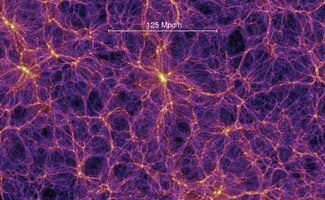Cosmology and Large Scale Structure
Cosmology is the science that studies the Universe as a physical entity and examines its overall properties, formation, and evolution. In the very earliest stages, the universe went through a phase of very rapid expansion (the inflation phase), which, among other things, caused small, initial fluctuations in the density field of matter. Gravity increased these fluctuations, causing matter to accumulate and stars, galaxies and clusters of galaxies to form. As a result, the universe is filled with a pattern known as the Large Scale Structure. This topic focuses on the processes that formed the structure we can observe today.
Topics
Kapteyn scientists have long been interested in the fundamental structure of the universe and the nature of dark matter. We focus on the following topics:
-
The nature of the initial conditions from which structure evolved.
-
The physical processes governing the evolution of structure at each stage.
-
The morphology and statistical properties of the Large Scale Structure of the universe.
-
The nature and amount of dark matter and dark energy.
-
Detection of the influence of first stars and mini-quasars, i.e. the Epoch of Reionisation (EoR) via HI.
Many of these topics are closely related to the research theme Galaxy Structure, Formation and Evolution.

Projects
The Kapteyn Institute's selected projects and programmes in this field are the search for HI 21-cm emission from the EoR with LOFAR and theoretical studies of the processes during the EoR and Cosmic Dawn.
Furthermore, the Cosmic Web is studied through theoretical studies and with APERTIF, which maps 105 HI sources in the near universe. With the Institute for Theoretical Physics, we jointly conduct research on the early universe and inflationary physics.

Future research
Future directions in cosmology and large structures include the analysis of Euclid data to study the origin of the Cosmic Web since early cosmic time. This will later be complemented by the scientific exploitation of the Square Kilometre Array (SKA).
Scientific staff
Scientific staff working in this field are: Caputi, Koopmans, Wang, van de Weijgaert, and Zaroubi.
